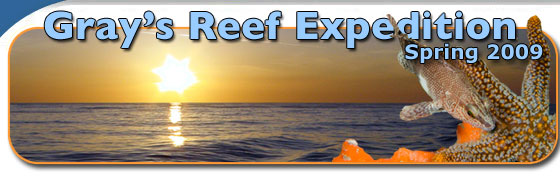Error processing SSI file
|
WELCOME ABOARD!
The 187ft NOAA Ship, Nancy Foster, will be operating within Gray’s Reef National Marine Sanctuary from June 8-19, 2009. Gray’s Reef National Marine Sanctuary is a 22 square mile area of live bottom reef off the coast of Georgia. Scientists aboard the Nancy Foster will be concentrating on four research projects:
1) Acoustic Fish Tagging and Tracking
2) Piscivore Ecology
3) Marine Debris Monitoring
4) Multibeam Mapping
We will be presenting daily mission logs on the website. So please tune in regularly to track our progress and experiences.
The primary objective of the cruise is to collect information to better understand, manage, and protect Gray’s Reef National Marine Sanctuary. The four research projects will be conducted at various times during the expedition. Additionally, we’ll be joined by three teachers. For more information on the personnel aboard the Nancy Foster, please visit our Meet the Team page.
In addition to the team on the ship, the project will be supported by three vessels based in Savannah and one from Brunswick. Out of Savannah, Gray’s Reef NMS research vessels 4106 and Sam Gray will be supporting efforts to collect fish for tagging and the Skidaway Institute of Oceanography’s Research Vessel Explorer will be used to support acoustic fish surveys. The Georgia Department of Natural Resources Research Vessel Marguerite will depart Brunswick each day to help collect fish for the tagging project. Clearly this mission is a partnership of many organizations and requires enormous effort to accomplish! Of course none of this would be possible without the tremendous support of the Officers and crew of the NOAA Ship NANCY FOSTER. Please visit the ship’s web site to learn more about this platform and her capable crew.
The following provides a brief synopsis of the four projects being supported during this cruise:
Acoustic Fish Tracking and Tagging
Continuing from the cruise last year, scientists aboard the Nancy Foster will be tagging red snapper, gag, and scamp. Scientists will capture and surgically implant an acoustic transmitter into 35 fish with the help of the Georgia Department of Natural Resources. These fish will then be released back into the sanctuary to live out the rest of their days. To track the movement of tagged fish, divers will deploy ten acoustic receivers within the sanctuary. These receivers detect and record each time a tagged fish is within range of the receiver. This helps us understand movement patterns of these fish.
Piscivore Ecology
A new project to the Nancy Foster this year is the piscivore ecology project. The objective of this project is to better understand the food web at Gray’s Reef. Scientists will be concentrating on the role of predators in the water column, the response of prey when a predator is present, and the link between feeding rates and population processes of demersal reef piscivores. This work will be done using divers to quantify behavior of the fish and the rates of predation that occur. Diver observations will be supported by the use of hydroacoustic survey systems and high frequency sonar to map fish distribution and movement over a broader area.
Marine Debris Monitoring
In previous years, nine monitoring stations were selected to indentify the type and sources of marine debris These nine stations are revisited on a regular basis to estimate the amount of marine debris that accumulates in Gray’s Reef annually. This process requires a team of divers to visit each of the nine stations, conduct surveys and record information on type and amount of debris found at the site. Debris is also collected for proper disposal.
Multibeam Mapping
Similar to work done in previous years, the Nancy Foster will be conducting multibeam mapping of areas around the sanctuary. During this year’s cruise, mapping will continue in areas adjacent to the sanctuary to the east and north. The data collected on this project will provide needed information on what habitats surround the sanctuary.
To accomplish the ambitious goals of this mission requires an extensive and dedicated team. Participants represent an impressive collection of organizations, including:
|



